Equinox Star Eras
by John P. Pratt
13 Apr 2019, 1 Ari (S), End Passover (E)
©2019 by John P. Pratt. All rights Reserved.
Index,
Home
Equinox star eras based on the Enoch Calendar determine Star Calendar precession simply and accurately.
This article proposes the method in which the Star Calendar (S) implements the precession of the equinoxes. It is simple and elegant, yet extremely accurate, making it easy for anyone to know the small adjustments to apparent star positions which are necessary because of their very slow shifting. This article explains how the star day on the Spring Equinox holy day on the Enoch Calendar (E) remains unchanged during each "equinox star era" of either 455 or 546 years.
1. Precession
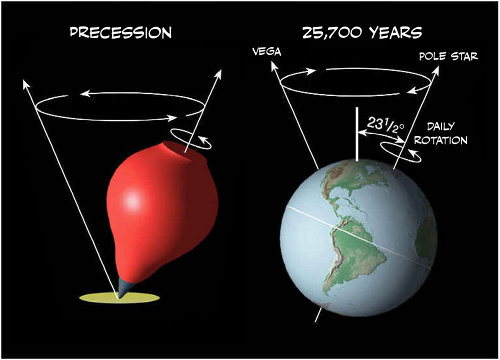 |
Fig. 1. The earth precesses like a top.
The Star Calendar needs to account for what is called the "precession of the equinoxes". That is the phenomenon that the stars appear to shift slightly through the seasons because the earth is precessing like a top (See Figure 1). Because of that precession, the north polar axis of the earth draws a big circle of 47° diameter in the sky over a period of 25,772 years.[1] That causes a major shift in star positions over the centuries, even causing some to always stay below the horizon at a given location, so that they are no longer visible there. The shift is very slow, only amounting to about 1° every 72 years.
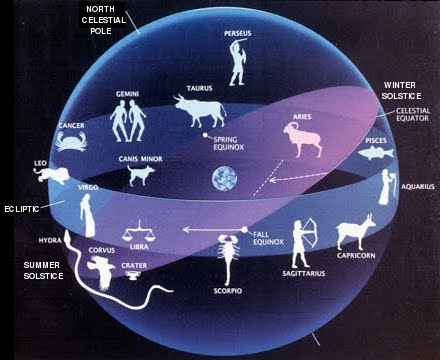 |
Fig. 2. Precession causes the equinoxes and solstices to move around the zodiac circle.
The way in which the shift is usually measured is by observing what stars are rising with the sun on the spring equinox, also known as the vernal equinox, or first day of spring. That day usually occurs on 20 March each year. For example, in the early days of history, the sun rose in the constellation of the Bull (Taurus) on the day of the spring equinox as shown in Figure 2 (look for the "Spring Equinox" point just above the earth). Visualize the band of zodiac constellations remaining fixed in space, as they indeed do, while the disc shown is spinning around like the coin in Figure 3. That disc contains the point of the spring equinox in the sky. As the disc makes one revolution every 25,772 years, that point moves around the zodiac circle from the Bull to the Ram (Aries) and then to the Fishes (Pisces), where it currently is located.
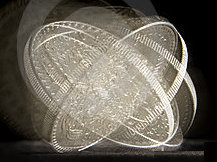 |
Fig. 3. Spinning coin.
The Star Calendar needs to accurately keep track over the centuries of exactly which star is rising on the day of the spring equinox. Until now, it has been assumed in my work that the Star Calendar had its own independent system to keep track of the position of the stars, even as the Enoch Calendar tracks the seasons of the sun. Recently, however, problems were noticed with that assumption. It was discovered that the Star Calendar includes holy days which are tied to the seasons of the earth. Consider, for example, the Hebrew Passover feast. That feast originally regulated the Hebrew calendar year because it was required to occur at the first full moon on or after the spring equinox, on the Hebrew Calendar day 15 Nisan. Similarly, it turns out that the Star Calendar also has a "Passover Feast" on the 15th day of the first zodiac month on or after the spring equinox. Even as the sun rises in one zodiac constellation for about 2,000 years, the Star Calendar also has "feast ages" of about 2,000 years in which its Passover stays in the same constellation. This was all explained in more detail in an earlier article.[2]
These seasonal Star Calendar feast days require access to two facts beyond simply looking at the stars. First, it requires knowing when the spring equinox occurs. Second, it requires determining when the equinox point precesses to a new star. The problem is to know how the Star Calendar determines those two entities. Calculating the spring equinoxes and star positions separately from the Enoch Calendar led to much confusion because the stars were being calculated by the position of the true equinox whereas the Spring Equinox (E) day varies from about 18 March to 31 March because it must always occur on a Saturday when the moon is not full.
The problem is best seen with the Star Calendar feast ages. It would seem best, for example, to have a clean break between the Feast Age of Taurus and that of Aries. In the earlier article, all that could be concluded was that the transition between those ages occurred somewhere around 600 BC. That shift, however, did not seem clear because for many years the equinox would shift between the Ram and the Bull. How were the ancients to know which age they were in? It would be so much simpler to have the exact transition year indicated on their calendar.
Let us now turn to a very simple solution, which God does indeed seem to be using.
2. Enoch Calendar Use
Let us now look at how the Enoch Calendar can be used to provide the needed information for the Star Calendar to indicate just which star day coincides with the spring equinox during any given year of history.
2.1 Enoch Equinox
The answer to the first problem of how to determine the date of the spring equinox is simply to use the Spring Equinox (E) holy day as the yearly definition of the date of the spring equinox. Even though it varies over a two week period from the true value, it does provide a definitive date. Remember that none of the sacred calendars studied in my work track the actual positions of celestial bodies but use a symbolic nearby representative date. Thus, let us consider using the Spring Equinox (E) date. It should not be surprising to use the Enoch Calendar because, after all, it was in the Book of Enoch that the Star Calendar was described. Thus, the two might well form a set to be used in tandem.
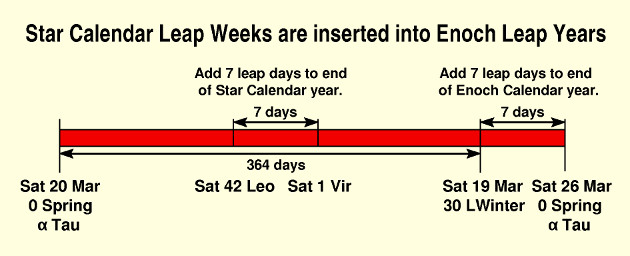 |
Fig. 4. Star Calendar leap weeks are inserted during Enoch leap years.
Figure 4 shows the manner in which inserting a typical leap week every few years into the Star Calendar is tied to the Enoch Calendar so that the same equinox star will be used every year during its own era. The year shown is a 364-day Enoch year starting on a Sat 20 Mar, being the Spring Equinox (E) on 0 Spring with the equinox star of Aldebaran (α Tau). It is an Enoch leap year, so there is an extra week added at the end of it, so that the next year begins on Sat 26 Mar being 0 Spring.
If nothing were done to adjust the Star Calendar, then the star α Tau would fall 364 days after the beginning of the graph, so its day would be Sat 19 Mar on the next year. Thus, to keep the equinox star date occurring on 0 Spring, it is necessary also to insert 7 days into the Star Calendar during that Enoch year. Those days must be added after the last day of the Star Calendar year, being 42 Leo. The illustration shows that week being inserted during the Enoch year (between June and October, slowing varying throughout history), which pushed the Star Calendar New Year Day (1 Vir) to be a week later. Accordingly, all of the star days thereafter are advanced one week, with the effect being that the star α Tau will occur on Sat 26 Mar and 0 Spring of the next Enoch year. Thus, the star α Tau remains the equinox star after both intercalations are completed.
2.2 Equinox Star Eras
Now consider the second problem of how to define a transition date between different spring equinox stars. We might expect that the star day could simply change to the next star every 72 years, but that is not allowed. Remember that, like the Enoch Calendar, the Star Calendar only inserts entire leap weeks at a time, not single days. Thus, changing what star is rising on the spring equinox requires waiting about 7 x 72 years, or about 504 years.
It is time to consider this problem more precisely in terms of inserting leap weeks to account for precession. There are exactly 52 weeks in an Enoch year. Shifting the equinox star by 52 weeks corresponds to one complete precession cycle of 25,772 years. How can that be done in a way easy to understand by using the Enoch Calendar?
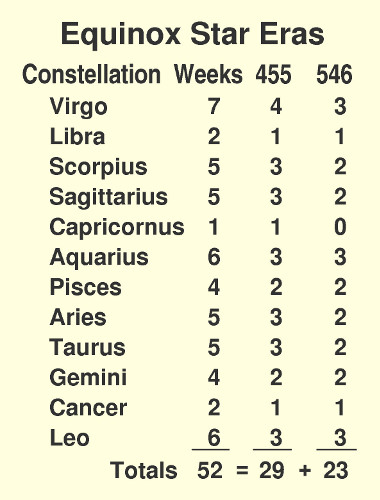 |
Table 1. Alternate star weeks to divide precession cycle into 52 eras of 455 or 546 years each.
The Enoch Great Year is divided into four quarters of 91 years each. One way to model precession is to use those 91-year quarters with the transition date occurring in either an EQUINOX or SOLSTICE year (0 SPR, 0 SUM, 0 AUT or 0 WIN) so that a new star would begin to reign over its era in the next year, being the first year of a 91-year quarter. Using two different lengths of five or six quarters, that is, either 455 (5 x 91) or 546 (6 x 91) years, one can approximate the precession cycle as 29 x 455 + 23 x 546 = 25,753 years. That is extremely close to the actual value of 25,772 years! How might that be implemented? One way would be simply to alternate 455 and 546 periods, starting with 455, through all of the zodiac constellations according to how many weeks each contains. Table 1 shows how that simple alternation of era lengths results in 29 eras of 455 years and 23 of 546.
One final detail of the implementation is that during the year of changing spring equinox stars an extra leap week on the Star Calendar would be inserted at the end of that Star Calendar year. For that to be possible, it means that none of those transition years could already be a leap year on the Enoch Calendar. Each proposed year of transition was verified not to be a leap year year (E). Thus, the manner of adding the extra leap week is exactly as shown in Figure 4, with the difference that the Enoch year is not a leap year. Thus, in that figure, the day Sat 19 Mar would be the new 0 Spring day (Spring Equinox, E) and hence would no longer fall on the star day of Alpha Tau, but on the star one week earlier, in this case Alcyone in the Pleiades. That star would then reign for the next entire equinox star era.
3. Results
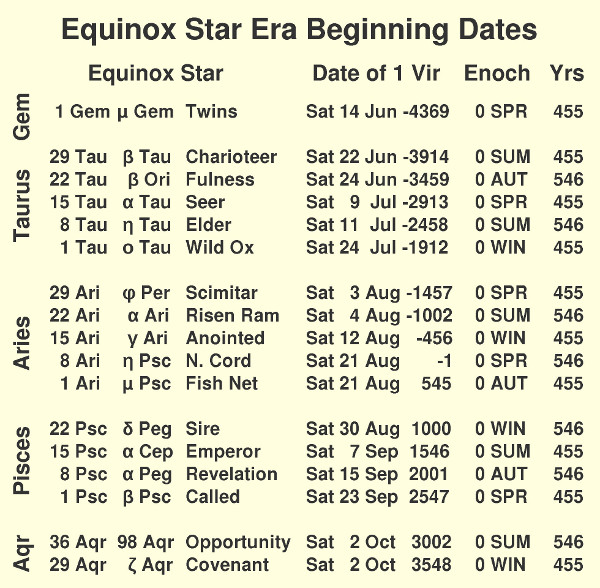 |
Table 2. Beginning dates of equinox star eras.
The result of dividing time into equinox star eras is shown in Table 2. The rows are divided according to the zodiac constellation. The first three columns identify the equinox star by the date of the zodiac month, astronomical designation, and English name. That name might be thought of as the name of the era. The next column lists the beginning date of the Star Calendar year (1 Vir) after inserting the extra week before it. Then the year (E) is listed to verify that it is always an equinox or solstice year, which makes it easy to know when the equinox star will change. Finally, the length of that era is listed. Note that they alternate between 455 and 546 years, beginning with 455 on day 1 of each constellation and moving upward through the constellation. For example, the first entry on 1 Gem is of length 455 because it is on the first day of that constellation. Similarly, 1 Tau, 1 Ari, and 1 Psc are also of length 455 years. This alternating results in 3 eras of 455 days and 2 of 546 in both Taurus and Aries. These numbers of 3 and 2 are seen in Table 1 in the rows for those constellations.
Further research might indicate whether or not these eras correlate to specific religious ages. For example, the Era of 15 Tau (α Tau) begins just after the translation of Enoch in 2948 BC and of the birth of Noah five years later. Then the next era begins shortly after the Deluge and includes the lives of the Abraham and Isaac. The following age begins with Jacob and lasts through the beginning of the Exodus. Then the next age begins during the 40 years in the wilderness after the Exodus, which truly seemed to mark a division between Israel's long sojourn in Egypt and the beginning of their existence as a nation in their promised land. The next era includes King David and Solomon's reign up through the exile of Israel and their return.
 |
Fig. 5. Christ was born 12 days after the first spring rising of equinox star η Psc.
An era began exactly in the year of the birth of Jesus Christ in 1 BC. Just twelve days[3] before His birth was the first time that the North Cord (Eta Psc) star day coincided with the Spring Equinox (E), thus opening that era. Truly, that year marked the beginning of the Christian Era! Moreover, that star represents the cord attaching the North Fish (His church) to the Sea Monster (Death), which cord He would break exactly on the day of His Resurrection.[4] The star η (Eta) in the Fishes can be seen in Figure 5 in the cord, just to the right of the Ram's horn. Thus, a possible meaning for this era suggests itself in a compelling manner.
What about later eras? One began in 1546 which fits well with the entire period of the Reformation and Restoration, starting near the birth of Martin Luther and lasting all the way through the time of the Prophet Joseph Smith. Interestingly, a new era began just four days after the Twin Towers fell which indeed has been burned into everyone's memory so strongly that it indeed may have marked the beginning of the reign of the Anti-Christ, the destruction of the proud and wicked, the founding of Zion, return of the Enoch's city, and the Second Coming. Moreover, the following era ends almost exactly in AD 3000, marking the end of 7,000 years since mortality began. The last era will continue through the end of the "little season" thereafter.
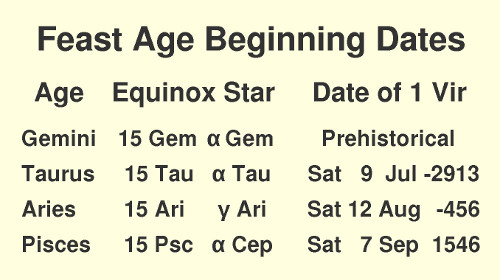 |
Table 3. Beginning of each feast age.
An entirely different set of results can also be gleaned from Table 2. The eras can determine the grouping of those equinox star ages into "feast ages" according to when the Star Calendar feasts transition from one zodiac constellation to the next as governed by the spring star being on or after the star day 15 of each zodiac constellation. Table 3 has extracted the era dates of 15 Tau, 15 Ari, and 15 Psc from Table 2 because those dates are the beginning dates of those feast ages. It shows when the 15th day of that constellation (roughly halfway through the zodiac era) becomes the equinox star, which is when the feast days all change. In the recent article on zodiac feast days[5], all that could be concluded was that the Feast Age of Gemini ended about 3000 BC, the Feast Age of Taurus ended about 600 BC, and the Feast Age of Aries ended about 1700. Indeed, it was the uncertainty in those dates and the confusion of the transition period which led to the discovery being announced in this article.
Now, by using Table 3, the precise transition day can be pinpointed. The Feast Age of Gemini lasted until Sat 9 Jul 2914 BC (-2913), which was the first time that the star on 15 Tau (Aldebaran, α Tau) would rise on the Spring Equinox (E). Before that day the equinox star was 22 Tau, meaning that 15 Tau had already risen before the equinox. For Passover (S) it must rise on or after the equinox (E), so 15 Tau could never before have been the Passover star. Table 3 similarly indicates that the Feast Age of Taurus ended in 457 BC and that of Aries ended in 1546. The Feast Age of Pisces will last until 15 Aqr is the equinox star, which will be after the Millennium.
These feast ages also require more investigation. There are probably many mysteries hidden in the dates of both the equinox star eras and also the feast ages.
4. Conclusion
A solution is proposed to explain exactly how the precession of the equinoxes can be handled by the Star Calendar simply and accurately. First, inserting leap weeks according to the Enoch Calendar can be used in nearly every year, making it possible for one single star day always to fall on the Spring Equinox (E) for the approximately five centuries when that one star is indeed near the spring equinox day. Then the adjustment needed after that period of time to the next star can be made during EQUINOX or SOLSTICE years on the Enoch Calendar, which occur every 91 years. The transition could take place after five or six periods (455 or 546 years), each called an "equinox star era", in a manner that all of those 52 ages would total to 25,753 years, extremely close to the true value of 25,772 years for the entire precession cycle. That way one star would reign over an entire equinox age and then transition smartly to a new age, both being associated with the Enoch Calendar.
Using this system noticeably improves the number of Star Calendar holy days occurring on the already proposed dates of several sacred events from history, indicating that this system might well be that used to witness of His works by the Creator!
Notes
- This accurate value of 25,772 years from the Encyclopedia Brittannica differs from the often quoted value of 25,920 years, which is the approximation used by the Hebrew Calendar and hitherto in my work. For example, the Hebrew day is divided into 25,920 "parts" (chalakim) instead of 86,400 seconds as in our Babylonian system of dividing hours into minutes and seconds. That value of 25,920 years comes out neatly to exactly 1° every 72 years and also 50" of arc per year. The true length of the precessional cycle is introduced in this article to emphasize the accuracy of equinox star eras.
- Pratt, John P., "Zodiac Feast Ages and Holy Days" (17 Mar 2019).
- The "twelve days of Christmas" tradition apparently goes back to when some early Christian Churches believed the Jesus was born 12 days after the spring equinox. At the time of Christ, the equinox was believed to occur on 25 March and 12 days later was 6 April. St. Augustine changed it so that Christ was born on 6 January, 12 days after the winter solstice on 25 December. When the Catholic Church divided, the Roman version held Christmas on 25 December, but the Eastern Church held to Jesus being born on 6 January. Later, to reconcile the two, the Eastern Orthodox Church changed to celebrate 25 December as Christmas and 6 January as Epiphany, the date of the visit of the magi 2 years later. The reason the 12 number shows up again now is that in that year of Christ's birth the Spring Equinox (E) was on Sat 25 Mar 1 BC (G) (i.e. on 25 March like the tradition).
- Pratt, John P., "Zodiac Feast Ages and Holy Days" (17 Mar 2019) Section 2: Feast Star Days.
- Pratt, John P., "Celestial Witnesses of Christ Breaking the Bands of Death", Meridian Magazine (26 Apr 2001), Section 3: Cutting the Bands of Death.








